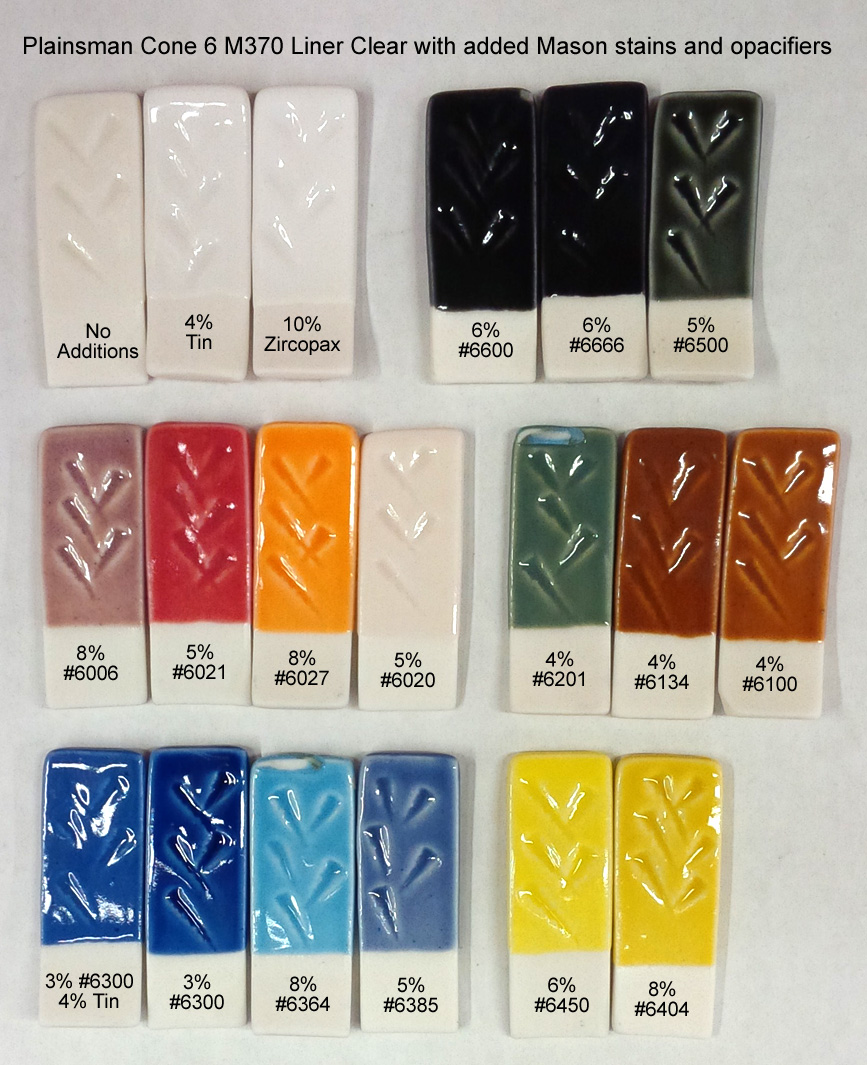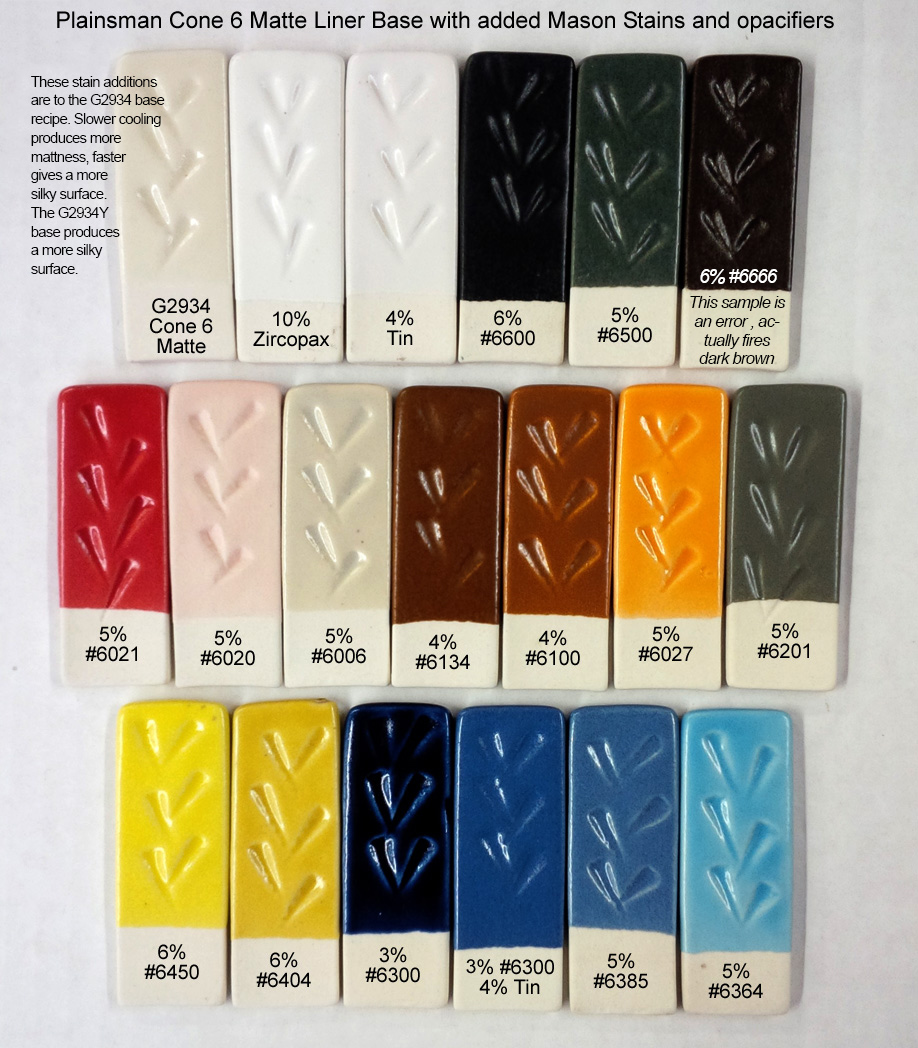| Monthly Tech-Tip | No tracking! No ads! | |
Medium Temperature
These are stoneware glazes that fire in the range of 1200C (2200F). They often contain boron to assist with melting.
Key phrases linking here: medium temperature, medium-temperature, middle-temperature - Learn more
Details
In functional ceramics, this term generally refers to glazes and bodies that mature from cone 4 to 7.
Bodies
Mixtures of natural light or white burning minerals and clays almost always produce bodies that do not mature or vitrify until cone 10. This is because whiter burning clays are more chemically pure, thus contain little or no feldspar. To produce a body that will vitrify at cone 6 generous feldspar additions are thus needed (PV clay is a notable exception). Bodies made using kaolin and ball clay can require up to 40% feldspar to mature, this is a challenge because the feldspar addition comes at a big cost to the plasticity (a further plasticity hit is that silica is also almost always needed, reducing clay content to 50% or even less). Darker burning clays contain iron oxide and other minerals, it is common for them to mature at or even below cone 6 on their own (although some red fireclays do exist).
Glazes
At these medium temperatures, it is difficult to compound glazes that will melt well without the need for powerful melters like zinc and boron. Thus, a medium temperature glaze contains mostly the same kinds of ingredients as a high temperature one, but additionally, it typically needs a power flux (boron is by far more popular and less troublesome for potters, whereas industry uses zinc/boron for fast firing. Typically, frits are employed to supply the B2O3 or ZnO (historically in pottery Gerstley Borate and Colemanite were common sources of B2O3, but industry uses frits). Boron has a low thermal expansion and thus is an ideal additive since it reduces the tendency of glazes to craze. Since there are no practical insoluble sources of pure boron, glaze chemistry is normally needed to determine how to best incorporate boron-sourcing materials into recipes that use troublesome natural sources.
Related Information
Plainsman M2 being delivered at the plant site in 2015

This picture has its own page with more detail, click here to see it.
M2 is a dark red burning, middle temperature, moderate plasticity, low contaminant stoneware clay. It makes a great base for brown firing low and medium temperature clay bodies, less than 50% is needed for good body color. Plainsman Clays has been surface-mining it in Montana and importing it to Alberta since 1980.
Iron red glazes

This picture has its own page with more detail, click here to see it.
I worked on this G3948A cone 6 glaze effect for 40 years! Now I have it. Here are the secrets:
-A fluid-melt glaze having the right chemistry for the iron to crystallize.
-The right amount of iron oxide in the recipe (too much and it over-crystallizes, too little and the effect is compromised.
-A dark burning clay body or engobe underneath, in this case, Plainsman Coffee Clay (we also use L3954F engobe on lighter clays).
-The right firing schedule (initially we used the C6IRED schedule but later we found the C6DHSC worked well also).
-An electronic controller and kiln packing density for a repeatable firing curve.
-Careful control of slurry thixotropy and rheology to enable consistently thick enough application that the melt runs (thus a catcher glaze is needed).
This cost about $20/kg to make in 2024 (enough to make more than two 500ml jars of brushing glaze).
The Magic of Rutile Glazes!

This picture has its own page with more detail, click here to see it.
Rutile is a high iron and titanium mineral mined in Sudbury, Ontario. When kilns cool this glaze "parties and dances", creating amazing rivulets and crystals of blue and navy. Both of these glazes are made from materials mined by Plainsman Clays (in Montana, Alberta, Saskatchewan). Both produce a wide range of effects with different thickness, bodies and firing schedules. This effect is achieved by firing to cone 6 (2200F) and slow cooling down to 1400F.
G2926B cone 6 transparent liner glaze: Proven, reliable, durable

This picture has its own page with more detail, click here to see it.
While colorful and layered glazes on the outsides of pieces get lots of praise and glory, transparent or white glazes providing the functional surface on the insides of pieces often get little attention from potters. Really, what good is an attractive piece if the food surface is crazing, blistering, leaching or cutlery marking? Or if it converts the piece into a time bomb? This cone 6 liner glaze, G2926B, is an example of how I found a glaze, recognized its potential and then adjusted the recipe to resist crazing on our clay bodies, fire durable and leach resistant and act as a base to host colorants, opacifiers and variegators. I get the best fired results using the C6DHSC firing schedule and very good performance as a dipping glaze when the slurry is thixotropic. One of the reasons this recipe is so widely used is that it is well-documented, having a code number that Google indexes. Drinking from a mug having a quality and fitted functional surface and a nice crisp line dividing the outside and inside glazes instills pride in me as the maker. What is the outside glaze? It is the G2934Y matte base recipe plus 8% Mason 6027 stain. The clay is MNP which I make myself.
G2934 cone 6 DIY MgO matte glaze: Reliable, durable, adjustable, stainable

This picture has its own page with more detail, click here to see it.
These pieces were made from Plainsman Polar Ice and fired to cone 6 using variations on the PLC6DS and C6DHSC schedules. The dipping glaze is G2934Y, a recipe variant of G2934 having a finer micro-surface texture (it has the same chemistry but the MgO is sourced from a frit and talc instead of dolomite). These mugs display how well the recipe works with stains and the varying degrees of matteness we can achieve by varying the cooling rate and the percentage of glossy G2926B base blended in. As an MgO matte, this glaze can have a surface pleasant to the touch. It fires durable, can be quite matte without cutlery marking and it has very good slurry and application properties (as a dipping glaze). It has a very low thermal expansion (won’t craze). It works really well with stains (except purples). It melts even better than the glossy!
Mason stains in the G2926B base glaze at cone 6

This picture has its own page with more detail, click here to see it.
This glaze, G2926B, is our main glossy base recipe. Stains are a much better choice for coloring it than raw metal oxides. Other than the great colors they produce here, there are a number of things worth noticing. Stains are potent; the percentages needed are normally much less than for metal oxides. Staining a transparent glaze produces a transparent color, it is more intense where the laydown is thicker - this is often desirable in highlighting contours and designs. For pastel shades, add an opacifier (e.g. 5-10% Zircopax, more stain might be needed to maintain the color intensity). The chrome-tin maroon 6006 does not develop well in this base (alternatives are G2916F or G1214M). The 6020 manganese alumina pink is also not developing here (it is a body stain). Caution is required with inclusion stains (like #6021). Bubbling, as is happening here, is common - this can be mitigated by adding 1-2% Zircopax. And it’s easy to turn any of these into brushing or dipping glazes.
Mason stains in the G2934 matte base glaze at cone 6

This picture has its own page with more detail, click here to see it.
Stains can work surprisingly well in matte base glazes like the DIY G2934 recipe. The glass is less transparent and so varying thicknesses do not produce as much variation in tint as glossy bases do. Notice how low many of the stain percentages are here, yet most of the colors are bright. We tested 6600, 6350, 6300, 6021 and 6404 overnight in lemon juice, they all passed leach-free. The 6385 is an error, it should be purple (that being said, do not use it, it is ugly in this base). And chrome-tin pink and maroon stains do not develop the color (e.g. 6006). But our G1214Z1 CaO-matte comes to the rescue, it both works better with some stains and has a more crystal matte surface. The degree-of-matteness of both can be tuned by cooling speed and blending in some G2926B glossy base. You can mix any of these into brushing or dipping glazes.
Two cone 6 matte glazes opacified with 10% Zircopax

This picture has its own page with more detail, click here to see it.
The clay is a buff stoneware. The upper two samples are G2934, an MgO matte. The one on the right has 10% zircon added to opacify.
The bottom two are G1214Z1 (transparent version and opacified-with-zircon version).
Links
| Oxides | B2O3 - Boric Oxide |
| Articles |
G1214M Cone 5-7 20x5 glossy transparent glaze
This is a base transparent glaze recipe developed for cone 6. It is known as the 20x5 or 20 by 5 recipe. It is a simple 5 material at 20% each mix and it makes a good home base from which to rationalize adjustments. |
| Articles |
Reducing the Firing Temperature of a Glaze From Cone 10 to 6
Moving a cone 10 high temperature glaze down to cone 5-6 can require major surgery on the recipe or the transplantation of the color and surface mechanisms into a similar cone 6 base glaze. |
| Typecodes |
Medium Temperature Glaze Recipes
Normally fired at cone 5-7 in electric kilns. |
| Glossary |
Glaze Chemistry
Glaze chemistry is the study of how the oxide chemistry of glazes relate to the way they fire. It accounts for color, surface, hardness, texture, melting temperature, thermal expansion, etc. |
| Glossary |
Borosilicate
|
| Glossary |
Boron Frit
Most ceramic glazes contain B2O3 as the main melter. This oxide is supplied by great variety of frits, thousands of which are available around the world. |
| Glossary |
Cone 6
Also called "middle temperature" by potters, cone 6 (~2200F/1200C) refers to the temperature at which most hobby and pottery stonewares and porcelains are fired. |
| Glossary |
Ceramic Glaze
Ceramic glazes are glasses that have been adjusted to work on and with the clay body they are applied to. |
| By Tony Hansen Follow me on        |  |
Got a Question?
Buy me a coffee and we can talk

https://digitalfire.com, All Rights Reserved
Privacy Policy
